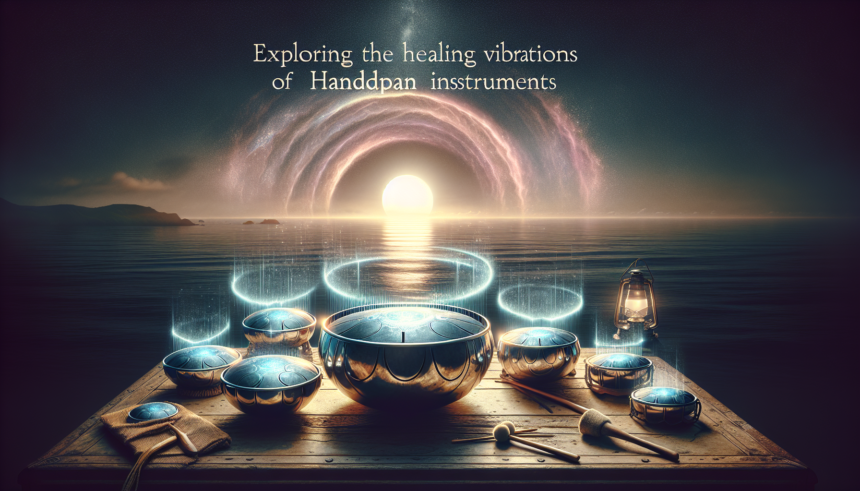The handpan is an enchanting and mesmerizing musical instrument that has captivated the hearts and ears of people around the globe. With its unique sound and meditative qualities, the handpan has become a popular choice for those seeking both musical exploration and mindfulness practices. But what exactly is a handpan, and what makes its vibrations so healing?
What is a Handpan?
The handpan is a relatively new musical instrument, invented in the year 2000 by Felix Rohner and Sabina Schärer in Switzerland. It is constructed from two metal half-shells that are glued together to create a resonant cavity. The top shell, or “dome,” is hammered and tuned to produce a rich and resonant sound. Each handpan consists of a central note, known as the “ding,” surrounded by a series of other notes arranged in a circle.
The instrument is played with the hands, hence the name “handpan.” Players use their fingertips, palms, and other parts of their hands to strike the different areas of the instrument, producing melodic and rhythmic patterns. The result is a sound that is both ethereal and grounding, making it a favorite among musicians, yoga practitioners, and meditation enthusiasts.
The Healing Qualities of Handpan Music
Handpan music is often described as soothing, calming, and meditative. This is due in part to the instrument’s unique tuning and harmonic qualities. The specific frequencies produced by the handpan can have a profound effect on the listener’s mind, body, and spirit. Here are some of the ways in which handpan music can promote healing and well-being:
1. Stress Reduction
One of the most immediate benefits of listening to or playing handpan music is its ability to reduce stress. The gentle and flowing sounds can help to slow down the heart rate, lower blood pressure, and alleviate tension in the body. This makes it an excellent tool for stress management and relaxation.
2. Meditation and Mindfulness
The repetitive and hypnotic nature of handpan music makes it an ideal accompaniment for meditation and mindfulness practices. The sound can help to focus the mind, deepen the breath, and bring about a state of present-moment awareness. Many people find that the vibrations of the handpan create a sense of inner peace and tranquility.
3. Emotional Healing
Music has long been recognized as a powerful tool for emotional healing, and the handpan is no exception. The instrument’s resonant tones can evoke a wide range of emotions, from joy and elation to sorrow and introspection. By allowing oneself to fully experience these emotions while listening to or playing the handpan, one can process and release feelings that may be stuck or repressed.
4. Enhanced Creativity
Many musicians and artists find that the handpan stimulates their creativity and inspires new ideas. The instrument’s unique sound palette provides a fresh canvas for musical expression, encouraging experimentation and improvisation. This can be incredibly liberating for those who may feel stuck in their creative endeavors.
5. Physical Healing
While the handpan cannot diagnose or cure medical conditions, many people report experiencing physical benefits from listening to its music. The vibrations created by the handpan can promote relaxation and reduce muscle tension, potentially aiding in pain relief and overall physical well-being.
Learning to Play the Handpan
For those interested in exploring the healing vibrations of the handpan, learning to play the instrument can be a deeply rewarding experience. While it may seem intimidating at first, the handpan is surprisingly intuitive and accessible to beginners. Here are some tips to get started:
1. Choose the Right Handpan
The first step is to select a handpan that resonates with you. Handpans are available in a variety of scales and tunings, each with its own unique character. Take the time to listen to different handpans and choose one that speaks to you on a personal level.
2. Start with Basic Techniques
Once you have your handpan, begin by familiarizing yourself with its layout and the different notes. Start with basic hand techniques, such as tapping with your fingertips or using your palms to create different tones. Exploring the various areas of the handpan will help you understand how to produce different sounds.
3. Explore Rhythms and Patterns
Experiment with simple rhythms and patterns, gradually building your confidence and skill. Play around with different combinations of notes and see what feels natural to you. Remember that there are no strict rules when it comes to playing the handpan—allow your creativity to guide you.
4. Practice Mindfulness
Playing the handpan can be a form of meditation in itself. Approach your practice with mindfulness, paying attention to each note and the sensations it evokes. This can deepen your connection to the instrument and enhance the healing experience.
5. Seek Guidance and Community
If you feel comfortable, consider taking lessons from a skilled handpan player or joining a handpan community. There are many online forums, social media groups, and workshops where you can connect with other handpan enthusiasts and learn from their experiences.
Handpan Music and Therapy
The handpan’s healing qualities have also found applications in various therapeutic settings. Music therapists, sound therapists, and holistic health practitioners often incorporate handpan music into their practices to support their clients’ healing journeys. Here are a few examples of how the handpan is used in therapy:
1. Sound Baths
Sound baths are immersive sound experiences where participants lie down and listen to live or recorded music. Handpans are frequently used in these sessions due to their soothing and meditative qualities. The vibrations of the handpan can help participants achieve deep relaxation and promote a sense of well-being.
2. Group Therapy
In group therapy settings, the handpan can serve as a unifying and grounding element. Participants can collectively create music, fostering a sense of connection and community. The shared experience of playing and listening to the handpan can facilitate emotional expression and support group cohesion.
3. Individual Therapy
In one-on-one therapy sessions, the handpan can be used to help clients relax, open up, and explore their emotions. The therapist may play the handpan to create a calming ambiance or encourage the client to engage with the instrument as a form of self-expression. The non-verbal nature of music can be particularly beneficial for clients who find it difficult to articulate their feelings.
4. Meditation and Mindfulness
The handpan can be a valuable tool for meditation and mindfulness therapy. Therapists may use the instrument to guide clients through mindfulness exercises, helping them to focus on the present moment and cultivate awareness. The sound of the handpan can enhance the therapeutic process and create a serene environment for introspection.
Handpan Music in Everyday Life
While the handpan’s healing qualities are often highlighted in therapeutic settings, its benefits can be enjoyed by anyone in everyday life. Here are some simple ways to incorporate handpan music into your daily routine:
1. Morning Meditation
Start your day with a few minutes of handpan music during your morning meditation. The soothing sounds can set a positive tone for the day ahead, helping you to feel centered and grounded.
2. Relaxation Breaks
Take short breaks throughout the day to listen to handpan music and relax. This can help to reduce stress and increase your overall sense of well-being. Consider creating a playlist of your favorite handpan songs for easy access.
3. Evening Wind-Down
Use handpan music as part of your evening routine to wind down and prepare for sleep. The calming vibrations can help to relax your mind and body, making it easier to transition into a restful state.
4. Creative Projects
Play handpan music in the background while working on creative projects. Whether you’re painting, writing, or crafting, the instrument’s harmonious tones can inspire creativity and enhance your artistic flow.
5. Social Gatherings
Share the magic of handpan music with friends and family during social gatherings. Playing or listening to handpan music together can create a memorable and uplifting experience for everyone involved.
Conclusion
The handpan is a unique and captivating instrument that offers a wide range of healing benefits. Its soothing vibrations can reduce stress, enhance meditation, support emotional healing, stimulate creativity, and promote physical well-being. Whether you are a seasoned musician or a complete beginner, exploring the world of handpan music can be a deeply rewarding and transformative experience. By incorporating the healing sounds of the handpan into your daily life, you can cultivate a greater sense of peace, mindfulness, and connection to the present moment.
Frequently Asked Questions
-
What is a handpan made of?
A handpan is typically made from two metal sheets that are formed into a convex shape and then glued together. The top shell is hammered and tuned to create a series of notes, while the bottom shell is often left relatively plain, sometimes with a central hole to release the sound.
-
Do I need musical experience to play the handpan?
No prior musical experience is necessary to start playing the handpan. The instrument’s intuitive layout and simple playing techniques make it accessible to beginners. With practice, you can develop your own style and enjoy the meditative experience of creating music.
-
How do I care for my handpan?
Proper care is essential to maintain the quality and longevity of your handpan. Keep it in a protective case when not in use, avoid exposing it to extreme temperatures or humidity, and clean it regularly with a soft cloth. Some handpans require occasional oiling to prevent rust.
-
Can I use a handpan in therapeutic settings without being a trained therapist?
While trained therapists use handpans for specific therapeutic goals, anyone can incorporate handpan music into their personal relaxation and mindfulness practices. If you are interested in using the handpan in a professional therapeutic setting, consider seeking additional training in music or sound therapy.
-
Where can I purchase a handpan?
Handpans can be purchased from various makers and retailers around the world. It is important to research and choose a reputable maker to ensure you receive a quality instrument. Many handpan makers offer online audio samples and videos to help you find the right handpan for you.





